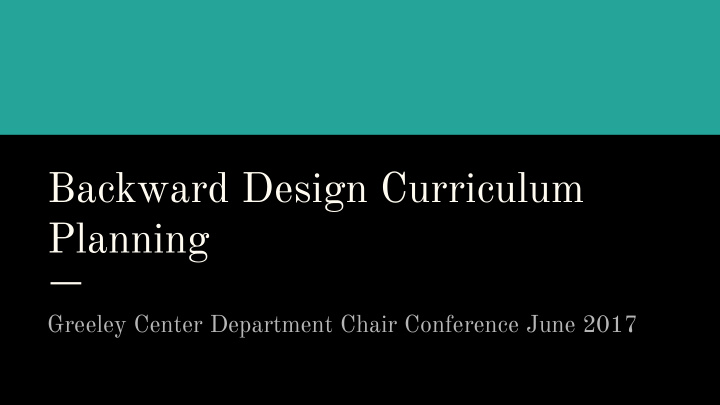



Backward Design Curriculum Planning Greeley Center Department Chair Conference June 2017
Outcomes ● Understand how utilizing Backward Design can strengthen your school’s academic program and the teacher experience ● Identify the components of Backward Design and how to implement this framework for curriculum development in your school
This Session’s Agenda 1. scenarios 2. Benefits of Backward Design 3. What is backward design? 4. Regina Dominican High School’s application of Backward Design
Scenarios 1) Read your assigned scenario and discuss questions as a group. 2) With remaining time, read and discuss additional scenarios
Are decisions about curriculum made in silos or collectively? Do we share common beliefs and practices related to curriculum design?
Benefits of Backward Design For the Teacher: ● Collaborative decision-making about most important outcomes of course ● Common pacing and assessment expectations ● Smooth transitions when assuming a new course
Benefits of Backward Design For the Student: ● Consistent flow to courses (common syllabi, unit structure) ● Ensures most important content/concepts are being taught despite teacher assignment ● Fair, meaningful assessments ● On-going, aligned learning from freshman to senior year
Benefits of Backward Design For the School: ● Ensures alignment with standards ○ Horizontal - among teachers teaching the same course ○ Vertical - among courses within a course sequence ● Documents the authentic curriculum of the school
Benefits of Backward Design For the Parents: ● Clarity of learning outcomes for courses ● Delivery of services as promised
What is backward design?
What is backward design?
Products of Backward Design 1. School curriculum map/course sequences 2. Department curriculum map - which courses teach which standards and outcomes 3. Syllabus 4. Unit plan 5. Daily lesson plans
What learning is essential? What do I want students to… Know Understand do
“What are the course outcomes?”
What is the goal of a final assessment? ● Determine mastery of course goals ● Did the students learn what I intended?
Stop and Reflect. How is this the same or different from your current method of planning?
Then use Wiggins & McTighe’s filters... 2) Does the concept have enduring value beyond the classroom? 3) Does the concept reside at the heart of the discipline? 4) Does the concept require analysis? 5) Does it have potential to engage students? (Do students need it?)
What really matters 5, 10, 20 years down the road? How will the courses in this discipline change the way our students think about ______________ ? How will these courses impact the future actions and decisions of our students? What skills from these course will our students need to carry forward for success in college and beyond?
Year- Long Plan Advanced American History
Stop and Reflect. How is this the same or different from your current method of planning?
RDHS What does this look like in Regina Dominican High School Practicalities and logistics
Recommend
More recommend